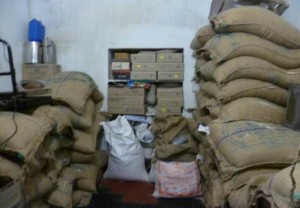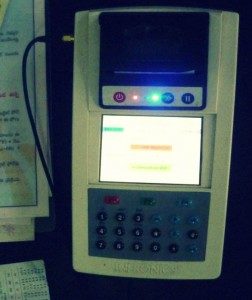by Amir Syed
Sep 27, 2013
5 min
In this blog, Amir Hamza shares the experiences on how the Aadhaar story is unfolding in East Godvari, India. Its implementation challenges, learning and impact.
At a time when the country is working to enrol 600 million Indians for Aadhaar by 2014, the East Godavari district in Andhra Pradesh has achieved remarkable results. With over 99.50% Aadhaar enrolments as of 25th December 2012, the district administration has set a remarkable precedent for others to follow. They are now able to leverage Aadhaar to deliver rations (under the public distribution system or PDS) through the fair price shops leased out by the Government.
PDS process in India
Every year, the Indian Government spends nearly Rs.750 billion to provide food security to people below the poverty line, and yet 21% per cent of India’s population remains undernourished. International Food Policy Research Institute notes that, despite an increase in food production by almost 50%, there is a little change in the proportion of undernourished in India.
There are numerous lacunae in the systems that block the transfer of rations to the poor. Food grains and other essentials are distributed at subsidised prices through the established network of fair price shops (FPS) spread across the country. Families below the poverty line who are eligible visit the FPS with their ration card. The distribution network constituting 5.05 lac (505,879) fair price shops is not without defects. There are several structural shortcomings with the system. These include:
- malpractices by the fair price shop owners making the food inaccessible to beneficiaries (many FPS are open only for a few days in a month and beneficiaries who do not visit the FPS on these days are denied their right. FPS also use multiple excuses to both charge higher rates and deliver reduced quantity of food grains);
- creation of a large number of ghost and bogus cards to sell the goods in the open market;
- the growing instances of beneficiaries receiving inferior quality food grains;
- the number of instances where benefits are being availed in the names of rightfully entitled families without their knowledge;
- irregular and diverse mechanisms adopted to identify households eligible for ration;and
- the lack of transparency and accountability at all levels making monitoring the system extremely difficult.
Government authorities have made several attempts to address these problems, yet with limited success.
The responsibility for regulating PDS, one of the oldest as well as the longest running, subsidy schemes in the country, rests with both central and state governments. While the central government is responsible for procurement, storage, transportation and bulk allocation of food grains, the state governments are responsible for the allocation and identification of families below the poverty line, issue of ration cards and supervision and monitoring the functioning of fair price shops.
Aadhaar Story in East Godavari
The district administration saw that Aadhaar can be used for the targeted delivery of food and civil supplies to the poor. To this end, the project was rolled out in four phases that covered:
- enrolment – in which KYR+ data (including ration card details, bank account information and mobile number was captured);
- seeding – which involved updating the ration card database of beneficiaries with the Aadhaar number and other details;
- roll out of Aadhaar enabled PDS; and
- Aadhaar enabled Ration Card Management System (AeRCMS).
The latter is yet to be implemented and will involve issuing a new ration card based on the Aadhaar number after authentication and de-duplication.
To execute the project in a timely and an effective manner, the district administration designed several key processes. To enrol the people for Aadhaar, a detailed village level implementation plan was prepared. Special personnel from the civil supplies department were deployed to carry out the project with well-defined roles and responsibilities. Training sessions were conducted to educate them about the core process related to the project. The Joint Collector of the district, who is the Additional Director of the Food and Civil Supplies Department of Andhra Pradesh, also conducted a few training programmes and monitored the progress and implementation of the project. A private firm was contracted to provide the Electronic Point of Sale (EPOS) machines through which the ration was distributed to the beneficiaries, upon authentication. A special technical team was put in place to address the technical snags that arose during the use of EPOS machines. Feedback mechanisms were set up to accelerate the project and most of the issues were resolved immediately after identification.
Impact of Aadhaar
The district administration has created a well-regarded demonstration model for implementing AePDS, with teams from various other districts visiting East Godavari to study this system. According to the report published by the district administration, the government is already saving up to Rs.44,274 ($800) per month in each of the 47 FPS in which the pilot was launched due to the elimination of the ghost and duplicate beneficiaries.
Aadhaar effectively addressed the problems of identification and distribution that have been hindering the PDS since its inception. It ensured the establishment of an effective system under which no deserving beneficiary is deprived of his/her ration. Alerting beneficiaries about the arrival of ration at the FPS, and about the timing of disbursement for each month, via an SMS to their mobiles has enhanced the transparency and accountability with which PDS operates. Setting up of EPOS machines for validation and authentication of beneficiaries has ensured that rations reach the targeted persons.
Learned and the way forward.
The project was piloted in 47 fair price shops where it has been operational since September, 2012. This has now been expanded to 100 of the total 2,561 shops in the districts. The administration faced numerous challenges during the pilot. The administration overcame challenges that included issues related to:
- training and capacity building of district functionaries involved in the project;
- low awareness levels of the AePDS among villagers; and
- network and connectivity issues for EPOS machines.
Effective mitigation strategies were adopted to counter these issues, allowing project achieve its objectives. The district administration is now focused on expanding the project to bring all the 2,561 fair price shops in the district under AePDS. Steps are being taken to manage this expansion and impending challenges like the supply of EPOS machines for all the fair price shops, and the provision of Aadhaar authentication for exceptional cases like old and disabled are already under review.
(A print of this article was published with IBN LIVE).
 by
by  Sep 27, 2013
Sep 27, 2013 5 min
5 min



Leave comments